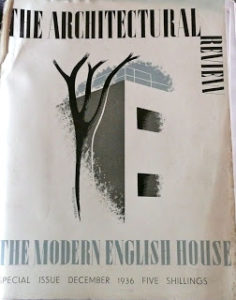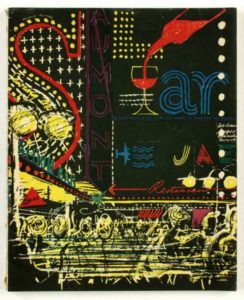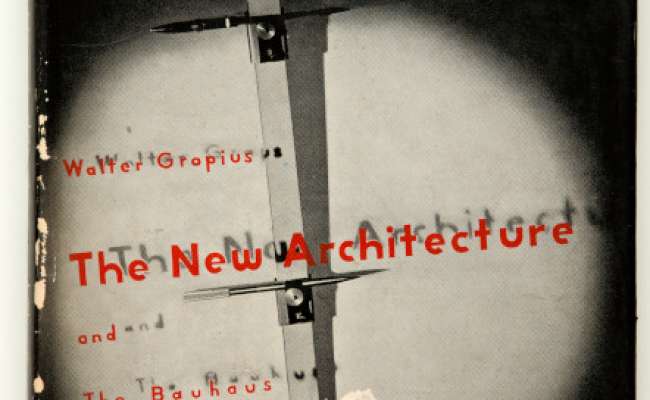Dr Jessica Kelly: Architectural Review magazine
Magazines such as Architectural Review are not just a way of finding out about the ‘real’ stuff of architecture (such as architects and buildings), but are a field of architectural production in their own right.
My research focused on JM Richards' role as editor of the Architectural Review from 1937 to 1971.

I am interested in the way in which the Architectural Review sought to shape public ideas about architecture between the 1930s and the 1970s.
MoDA holds unbound issues of the magazine covering most decades from the 1890s to the 1970s. These copies of the magazine, owned by Richards, formed a central part of my research. I explored the magazine’s relation to the various other media used by architects, artists, writers and critics in their efforts to influence the public’s relationship with modern architecture in the mid-twentieth century.
Research Background
Dr Jessica Kelly used the JM Richards Library at MoDA as the basis the research for her doctoral thesis, “To fan the ardour of the layman”: JM Richards, The Architectural Review, and discourses of modernism in British architecture, 1933-1972 (Middlesex University, 2013) http://eprints.mdx.ac.uk/13042/
She has subsequently written several articles about JM Richards and is working on a monograph entitled ‘No More Giants’: JM Richards, modernism and The Architectural Review for Manchester University Press.
Jessica now teaches at the University for the Creative Arts
Who was JM Richards?
James Maude Richards (1907-1992) trained as an architect at the Architectural Association School. He became a journalist at the Architect’s Journal in 1933. He moved to the Architectural Review in 1935, and became editor in 1937.
Richards’ career as editor of the Architectural Review spanned the era of the ascent and descent of modern architecture in British culture. He was well known as an author and commentator in his lifetime, but he is now regarded as a slightly peripheral character in histories of architecture and modernism.
However, Richards was particularly influential in reassessing the relationship between modernist architecture and the tradition of British vernacular styles, produced by and for ordinary people. He was interested in how architects could shape architecture in twentieth-century Britain, and he sought to understand the personal tastes and needs of the man in the street. In his book The Castles on the Ground, he aimed to foster a more effective and productive role for architects in developing the culture of twentieth-century Britain. The role he envisioned was not that of the ‘starchitect’, but of anonymous models that could provide a universal idiom of architecture.
The Architectural Review as ‘Mouthpiece of Modernism’
 Under the guidance of JM Richards as editor, the Architectural Review magazine became known for the beautiful design and innovative layout of its pages. The magazine frequently featured stunning architectural images by photographers such as Dell and Wainwright, and Eric de Maré. It has been has been described as the ‘mouthpiece of modernism.’
Under the guidance of JM Richards as editor, the Architectural Review magazine became known for the beautiful design and innovative layout of its pages. The magazine frequently featured stunning architectural images by photographers such as Dell and Wainwright, and Eric de Maré. It has been has been described as the ‘mouthpiece of modernism.’
“But I think the Architectural Review should be understood as more than a vessel for beautiful pictures or a transmitter of new ideas about architecture. Instead it was an active participant in the negotiation of these ideas and instrumental in the cultivation of audiences for them.”
Journals and magazines like Architectural Review are therefore objects that one can read not just for their content, but for the variety of ways in which they shaped the discourse of architecture, through the use of word and image, typography, lay-out, and advertisements. Similarly for Richards, architectural criticism was about more than judging buildings. Criticism was about negotiating the relationship between architecture and the world around it.
Richards’ architectural criticism in the late 1930s sought to consolidate the role of the modern architect as an expert in culture and to encourage public appreciation for modern architecture. The style and tone of Richards’ writing in the Architectural Review magazine and elsewhere signalled an evolution in the dynamic between critic, architect and public. Under his editorship, a more professional and technocratic tone was adopted, and the magazine became concerned with defining modern architecture as part of the contemporary ‘zeitgeist’. In other words, architecture should express the spirit of the age and ‘reflect the real, essential world of scientific order that underlies our one of the new tasks of the arts’. (Richards 1935, 211).
The Magazine as 'object'
One of the chief advantages of MoDA’s collection of the Architectural Review, is that unlike other library and museum collections where the magazines are bound in sixth month batches, at MoDA the magazines remain as individual issues complete with their front covers.
The benefit of unbound magazines is that you hold each issue as it would have been held by the original reader, which is a great feeling. It’s also helpful for research purposes – the size and weight of the magazine is significant if you’re thinking about how it might have been read or how it might be stored in a home or a club. Also, it makes comparison of the magazines easier. Because those in MoDA’s collection were Richards’ personal magazines, a few copies have annotations or slips of torn out articles included – giving an insight into how he used them.






